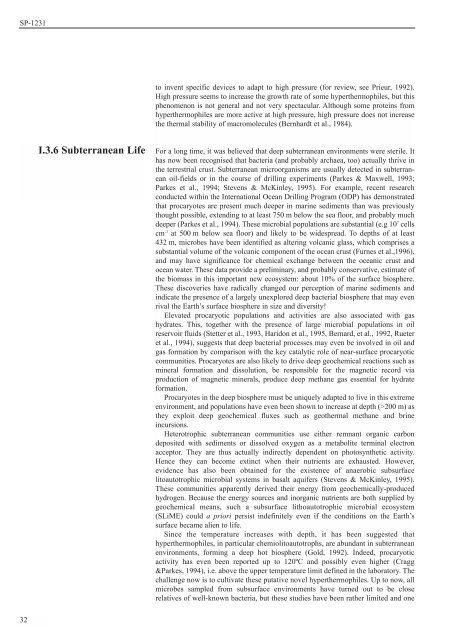Exobiology in the Solar System & The Search for Life on Mars - ESA
Exobiology in the Solar System & The Search for Life on Mars - ESA
Exobiology in the Solar System & The Search for Life on Mars - ESA
Create successful ePaper yourself
Turn your PDF publications into a flip-book with our unique Google optimized e-Paper software.
SP-1231<br />
32<br />
I.3.6 Subterranean <str<strong>on</strong>g>Life</str<strong>on</strong>g><br />
to <str<strong>on</strong>g>in</str<strong>on</strong>g>vent specific devices to adapt to high pressure (<str<strong>on</strong>g>for</str<strong>on</strong>g> review, see Prieur, 1992).<br />
High pressure seems to <str<strong>on</strong>g>in</str<strong>on</strong>g>crease <str<strong>on</strong>g>the</str<strong>on</strong>g> growth rate of some hyper<str<strong>on</strong>g>the</str<strong>on</strong>g>rmophiles, but this<br />
phenomen<strong>on</strong> is not general and not very spectacular. Although some prote<str<strong>on</strong>g>in</str<strong>on</strong>g>s from<br />
hyper<str<strong>on</strong>g>the</str<strong>on</strong>g>rmophiles are more active at high pressure, high pressure does not <str<strong>on</strong>g>in</str<strong>on</strong>g>crease<br />
<str<strong>on</strong>g>the</str<strong>on</strong>g> <str<strong>on</strong>g>the</str<strong>on</strong>g>rmal stability of macromolecules (Bernhardt et al., 1984).<br />
For a l<strong>on</strong>g time, it was believed that deep subterranean envir<strong>on</strong>ments were sterile. It<br />
has now been recognised that bacteria (and probably archaea, too) actually thrive <str<strong>on</strong>g>in</str<strong>on</strong>g><br />
<str<strong>on</strong>g>the</str<strong>on</strong>g> terrestrial crust. Subterranean microorganisms are usually detected <str<strong>on</strong>g>in</str<strong>on</strong>g> subterranean<br />
oil-fields or <str<strong>on</strong>g>in</str<strong>on</strong>g> <str<strong>on</strong>g>the</str<strong>on</strong>g> course of drill<str<strong>on</strong>g>in</str<strong>on</strong>g>g experiments (Parkes & Maxwell, 1993;<br />
Parkes et al., 1994; Stevens & McK<str<strong>on</strong>g>in</str<strong>on</strong>g>ley, 1995). For example, recent research<br />
c<strong>on</strong>ducted with<str<strong>on</strong>g>in</str<strong>on</strong>g> <str<strong>on</strong>g>the</str<strong>on</strong>g> Internati<strong>on</strong>al Ocean Drill<str<strong>on</strong>g>in</str<strong>on</strong>g>g Program (ODP) has dem<strong>on</strong>strated<br />
that procaryotes are present much deeper <str<strong>on</strong>g>in</str<strong>on</strong>g> mar<str<strong>on</strong>g>in</str<strong>on</strong>g>e sediments than was previously<br />
thought possible, extend<str<strong>on</strong>g>in</str<strong>on</strong>g>g to at least 750 m below <str<strong>on</strong>g>the</str<strong>on</strong>g> sea floor, and probably much<br />
deeper (Parkes et al., 1994). <str<strong>on</strong>g>The</str<strong>on</strong>g>se microbial populati<strong>on</strong>s are substantial (e.g 10 7 cells<br />
cm -3 at 500 m below sea floor) and likely to be widespread. To depths of at least<br />
432 m, microbes have been identified as alter<str<strong>on</strong>g>in</str<strong>on</strong>g>g volcanic glass, which comprises a<br />
substantial volume of <str<strong>on</strong>g>the</str<strong>on</strong>g> volcanic comp<strong>on</strong>ent of <str<strong>on</strong>g>the</str<strong>on</strong>g> ocean crust (Furnes et al.,1996),<br />
and may have significance <str<strong>on</strong>g>for</str<strong>on</strong>g> chemical exchange between <str<strong>on</strong>g>the</str<strong>on</strong>g> oceanic crust and<br />
ocean water. <str<strong>on</strong>g>The</str<strong>on</strong>g>se data provide a prelim<str<strong>on</strong>g>in</str<strong>on</strong>g>ary, and probably c<strong>on</strong>servative, estimate of<br />
<str<strong>on</strong>g>the</str<strong>on</strong>g> biomass <str<strong>on</strong>g>in</str<strong>on</strong>g> this important new ecosystem: about 10% of <str<strong>on</strong>g>the</str<strong>on</strong>g> surface biosphere.<br />
<str<strong>on</strong>g>The</str<strong>on</strong>g>se discoveries have radically changed our percepti<strong>on</strong> of mar<str<strong>on</strong>g>in</str<strong>on</strong>g>e sediments and<br />
<str<strong>on</strong>g>in</str<strong>on</strong>g>dicate <str<strong>on</strong>g>the</str<strong>on</strong>g> presence of a largely unexplored deep bacterial biosphere that may even<br />
rival <str<strong>on</strong>g>the</str<strong>on</strong>g> Earth’s surface biosphere <str<strong>on</strong>g>in</str<strong>on</strong>g> size and diversity!<br />
Elevated procaryotic populati<strong>on</strong>s and activities are also associated with gas<br />
hydrates. This, toge<str<strong>on</strong>g>the</str<strong>on</strong>g>r with <str<strong>on</strong>g>the</str<strong>on</strong>g> presence of large microbial populati<strong>on</strong>s <str<strong>on</strong>g>in</str<strong>on</strong>g> oil<br />
reservoir fluids (Stetter et al., 1993, Harid<strong>on</strong> et al., 1995, Bernard, et al., 1992, Rueter<br />
et al., 1994), suggests that deep bacterial processes may even be <str<strong>on</strong>g>in</str<strong>on</strong>g>volved <str<strong>on</strong>g>in</str<strong>on</strong>g> oil and<br />
gas <str<strong>on</strong>g>for</str<strong>on</strong>g>mati<strong>on</strong> by comparis<strong>on</strong> with <str<strong>on</strong>g>the</str<strong>on</strong>g> key catalytic role of near-surface procaryotic<br />
communities. Procaryotes are also likely to drive deep geochemical reacti<strong>on</strong>s such as<br />
m<str<strong>on</strong>g>in</str<strong>on</strong>g>eral <str<strong>on</strong>g>for</str<strong>on</strong>g>mati<strong>on</strong> and dissoluti<strong>on</strong>, be resp<strong>on</strong>sible <str<strong>on</strong>g>for</str<strong>on</strong>g> <str<strong>on</strong>g>the</str<strong>on</strong>g> magnetic record via<br />
producti<strong>on</strong> of magnetic m<str<strong>on</strong>g>in</str<strong>on</strong>g>erals, produce deep methane gas essential <str<strong>on</strong>g>for</str<strong>on</strong>g> hydrate<br />
<str<strong>on</strong>g>for</str<strong>on</strong>g>mati<strong>on</strong>.<br />
Procaryotes <str<strong>on</strong>g>in</str<strong>on</strong>g> <str<strong>on</strong>g>the</str<strong>on</strong>g> deep biosphere must be uniquely adapted to live <str<strong>on</strong>g>in</str<strong>on</strong>g> this extreme<br />
envir<strong>on</strong>ment, and populati<strong>on</strong>s have even been shown to <str<strong>on</strong>g>in</str<strong>on</strong>g>crease at depth (>200 m) as<br />
<str<strong>on</strong>g>the</str<strong>on</strong>g>y exploit deep geochemical fluxes such as geo<str<strong>on</strong>g>the</str<strong>on</strong>g>rmal methane and br<str<strong>on</strong>g>in</str<strong>on</strong>g>e<br />
<str<strong>on</strong>g>in</str<strong>on</strong>g>cursi<strong>on</strong>s.<br />
Heterotrophic subterranean communities use ei<str<strong>on</strong>g>the</str<strong>on</strong>g>r remnant organic carb<strong>on</strong><br />
deposited with sediments or dissolved oxygen as a metabolite term<str<strong>on</strong>g>in</str<strong>on</strong>g>al electr<strong>on</strong><br />
acceptor. <str<strong>on</strong>g>The</str<strong>on</strong>g>y are thus actually <str<strong>on</strong>g>in</str<strong>on</strong>g>directly dependent <strong>on</strong> photosyn<str<strong>on</strong>g>the</str<strong>on</strong>g>tic activity.<br />
Hence <str<strong>on</strong>g>the</str<strong>on</strong>g>y can become ext<str<strong>on</strong>g>in</str<strong>on</strong>g>ct when <str<strong>on</strong>g>the</str<strong>on</strong>g>ir nutrients are exhausted. However,<br />
evidence has also been obta<str<strong>on</strong>g>in</str<strong>on</strong>g>ed <str<strong>on</strong>g>for</str<strong>on</strong>g> <str<strong>on</strong>g>the</str<strong>on</strong>g> existence of anaerobic subsurface<br />
litoautotrophic microbial systems <str<strong>on</strong>g>in</str<strong>on</strong>g> basalt aquifers (Stevens & McK<str<strong>on</strong>g>in</str<strong>on</strong>g>ley, 1995).<br />
<str<strong>on</strong>g>The</str<strong>on</strong>g>se communities apparently derived <str<strong>on</strong>g>the</str<strong>on</strong>g>ir energy from geochemically-produced<br />
hydrogen. Because <str<strong>on</strong>g>the</str<strong>on</strong>g> energy sources and <str<strong>on</strong>g>in</str<strong>on</strong>g>organic nutrients are both supplied by<br />
geochemical means, such a subsurface lithoautotrophic microbial ecosystem<br />
(SLiME) could a priori persist <str<strong>on</strong>g>in</str<strong>on</strong>g>def<str<strong>on</strong>g>in</str<strong>on</strong>g>itely even if <str<strong>on</strong>g>the</str<strong>on</strong>g> c<strong>on</strong>diti<strong>on</strong>s <strong>on</strong> <str<strong>on</strong>g>the</str<strong>on</strong>g> Earth’s<br />
surface became alien to life.<br />
S<str<strong>on</strong>g>in</str<strong>on</strong>g>ce <str<strong>on</strong>g>the</str<strong>on</strong>g> temperature <str<strong>on</strong>g>in</str<strong>on</strong>g>creases with depth, it has been suggested that<br />
hyper<str<strong>on</strong>g>the</str<strong>on</strong>g>rmophiles, <str<strong>on</strong>g>in</str<strong>on</strong>g> particular chemiolitoautotrophs, are abundant <str<strong>on</strong>g>in</str<strong>on</strong>g> subterranean<br />
envir<strong>on</strong>ments, <str<strong>on</strong>g>for</str<strong>on</strong>g>m<str<strong>on</strong>g>in</str<strong>on</strong>g>g a deep hot biosphere (Gold, 1992). Indeed, procaryotic<br />
activity has even been reported up to 120ºC and possibly even higher (Cragg<br />
&Parkes, 1994), i.e. above <str<strong>on</strong>g>the</str<strong>on</strong>g> upper temperature limit def<str<strong>on</strong>g>in</str<strong>on</strong>g>ed <str<strong>on</strong>g>in</str<strong>on</strong>g> <str<strong>on</strong>g>the</str<strong>on</strong>g> laboratory. <str<strong>on</strong>g>The</str<strong>on</strong>g><br />
challenge now is to cultivate <str<strong>on</strong>g>the</str<strong>on</strong>g>se putative novel hyper<str<strong>on</strong>g>the</str<strong>on</strong>g>rmophiles. Up to now, all<br />
microbes sampled from subsurface envir<strong>on</strong>ments have turned out to be close<br />
relatives of well-known bacteria, but <str<strong>on</strong>g>the</str<strong>on</strong>g>se studies have been ra<str<strong>on</strong>g>the</str<strong>on</strong>g>r limited and <strong>on</strong>e

















